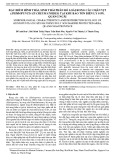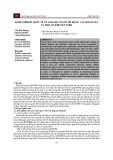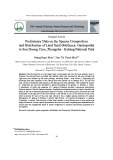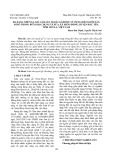
70 Duy Le, Dang Vo, Ky Hong Thai, Tuan Van Bui, Minh Tai Pham, Van Minh Vo, Chi Cuong-Doan, Luc Van Nguyen, Duc Minh Hoang
AVIFAUNA OF SON TRA PENINSULA: RECENT ORNITHOLOGICAL
SURVEYS WITH NOTABLE MIGRATORY BIRD RECORDS
Duy Le1*, Dang Vo3, Ky Hong Thai3, Tuan Van Bui2, Minh Tai Pham3,4,6, Van Minh Vo6,
Chi Cuong-Doan6, Luc Van Nguyen3,5, Duc Minh Hoang1
1Southern Institute of Ecology, Institute of Applied Materials Science,
Vietnam Academy of Science and Technology, Ho Chi Minh City, Vietnam
2HIVOOC Co.Ltd, Da Nang, Vietnam
3Birdwatching group, Da Nang, Vietnam
4HUONGSANG Environment & Biological Resources One Member Limited Liability Company, Da Nang, Vietnam
5Vietnam Tour Guide, Da Nang, Vietnam
6The University of Danang - University of Science and Education, Vietnam
*Corresponding author: leduy04h@gmail.com
(Received: July 02, 2024; Revised: September 26, 2024; Accepted: October 02, 2024)
DOI: 10.31130/ud-jst.2024.325E
Abstract - The Son Tra Peninsula supports a rich avifauna,
particularly migratory birds. However, few in-depth studies have
been conducted in the area. Between 2016 and 2018, a series of
ornithological surveys were conducted across 14 sites using
playback, mist-netting, and opportunistic observations along
existing roads and transects. A total of 215 bird species were
recorded, including 131 resident species, 11 passage migrants,
64 winter visitors, four vagrants, and five breeding visitors.
Notably, 105 species were new records for the peninsula, raising
the up-to-date checklist of birds to 256 species. The surveys also
provided updated data on five globally threatened species and
three species with recently extended ranges in Central Vietnam,
along with notes on unconfirmed birds and occurrences. There
was no robust evidence for the existence of Germain's Peacock-
Pheasant (Polyplectron germaini), which was last recorded two
decades ago without specific locality information.
Key words - Son Tra Peninsula; avifauna; migratory bird;
Germain's Peacock-Pheasant
1. Introduction
Located in the northeast of Da Nang City, the Son Tra
Peninsula (STP) is an isolated mountain block, with a
length of 13 km, and about 5 km at the widest part. The
STP is a part of the Greater Annamites Ecoregion, a
globally important region with general biodiversity and a
well-known bird hotspot [1], [2]. The peninsula occupies
part of a unique biogeographic transition zone between
northern and southern Vietnam. In 1977, most of the forest
area of the STP was designated as a Special-use Forest, the
Son Tra Nature Reserve. Previous bird surveys indicate the
relatively high diversity and abundance of avifauna in the
STP, with at least 161 species recorded [3].
Even though the STP is an important area for
biodiversity, its avifauna is still poorly known. Historical
ornithological studies can be traced back to the 1990s, with
the initial result of an avifauna report published in 1997 [4].
Several bird surveys conducted in 2013 - 2014 reported
many new national and regional records, including
migratory birds; notable for these surveys was a new
country record for Vietnam in 2017, the Yellow-throated
Bunting (Emberiza elegans) [5]. Despite these efforts, no
recent thorough bird survey has been carried out to provide
comprehensive information on the avifauna of the STP,
especially for threatened and migratory birds.
This paper aims to provide an overview of the species
diversity and distribution of birds in the STP based on
intensive surveys conducted over a three-year period from
2016 to 2018, supplemented by opportunistic observation
data on birds from our birdwatching group from 2013 to
2020 periods. We also discuss the status and distribution of
threatened and migratory birds, as well as species of
doubtful occurrences.
2. Materials and Methods
2.1. Study areas
We conducted bird surveys at 14 sites in STP. Surveys at
13 of these sites were carried out during both the winter and
summer seasons from 2016 to 2018. An additional site (site
14) was surveyed for 2 to 4 days in October-December and
March of 2017 and 2018 (Table 1, Figure 1). The study area
covers approximately 4,000 ha, with elevations ranging
from 5 m to 696 m (Oc Cao - the highest peak of STP). The
climate in this area is characterized by dry and hot summers
from March to August, and mild and rainy winters from
September to January. The land cover is divided into seven
types, dominated by degraded evergreen broadleaf forests
and regenerating evergreen broadleaf forests [6].
2.2. Avian surveys
At each site, we conducted four field surveys yearly,
averaging 10 days per field trip, divided into two field trips
per season. Bird surveys were primarily carried out using
opportunistic observations along existing roads and
transects across various elevations and habitat types
through daylight, beginning from dawn (6:00) and
continuing until dusk (18:00). Night surveys focusing on
nocturnal birds were carried out from 19:00 to 22:30 at
each site and along existing roads. To investigate
understory birds, we used three mist-nets measuring 2.6 m
× 6 m at each site. For all bird records, we documented the
number of individuals, habitat, altitude, date, sex, and age
where possible. Birds were identified visually using
binoculars and by their calls. The birds were identified

ISSN 1859-1531 - THE UNIVERSITY OF DANANG - JOURNAL OF SCIENCE AND TECHNOLOGY, VOL. 22, NO. 12, 2024 71
based on [7 - 10]. Taxonomy and nomenclature followed
[9], [10]. The distribution ranges of bird species within
Vietnam were guided by [9], [10]. The occurrence status is
categorized into five types: resident, winter visitor, passage
migrant, vagrant, and breeding visitor, with definitions
based on [8], [9].
Figure 1. Map of Son Tra Peninsula showing sites for bird surveys, in which, 1 = Gac Bo Doi, 2 = Xoai Kho,
3 = Bai Cat Vang - Le Hai Son; 4 = Suoi Om, 5 = Cau Can So 3, 6 = Ho Sau, 7 = Bai Bac, 8 = Vong Canh hill, 9 = Ban Co peak,
10 = Bamboo Garden, 11 = Linh Ung Pagoda, 12 = InterContinental Resort,13 = Son Tra Banyan, and 14 = Son Tra beach
Table 1. Major sites were selected to bird surveys in Son Tra Peninsula
No.
Site
Coordinates
Altitudinal range (m)
Habitat
1
Gac Bo Doi
N16°07'17.1"
E108°13'31.5"
27 - 156
Planted trees, mainly Acacia, Eucalyptus; Poor evergreen
broadleaf forest; grassland; residential land; agricultural land
2
Xoai Kho
N16°08'03.4"
E108°14'01.4"
152 - 197
Poor evergreen broadleaf forest; planted forest; bare land or
grassland
3
Bai Cat Vang - Le
Hai Son
N16°08'39.3"
E108°13'58.8"
27 - 128
Poor evergreen broadleaf forest; planted forest; bare land and
grassland; residential land
4
Suoi Om
N16°08'55.5"
E108°14'38.8"
109 - 198
Medium evergreen broadleaf forest; poor evergreen
broadleaf forest; grassland; residential land
5
Cau Can So 3
N16°08'10.6"
E108°15'30.6"
216 - 370
Medium evergreen broadleaf forest; poor evergreen
broadleaf forest; grassland
6
Ho Sau
N16°07'49.0"
E108°16'32.1"
67 - 372
Medium evergreen broadleaf forest; poor evergreen
broadleaf forest; grassland
7
Bai Bac
N16°07'23.2"
E108°17'54.4"
67 - 252
Medium evergreen broadleaf forest; poor evergreen
broadleaf forest; planted trees; grassland; residential land
8
Vong Canh hill
N16°08'06.1"
E108°14'45.6"
402 - 576
Poor evergreen broadleaf forest; medium evergreen
broadleaf forest; bare land and grassland; residential land
9
Ban Co peak
N16°07'09.3"
E108°16'19.3"
445-620
Medium evergreen broadleaf forest; poor evergreen
broadleaf forest; grassland; residential land
10
Bamboo Garden
N16°06'48.6"
E108°15'22.5"
16 - 118
Planted trees, mainly Acacia, Eucalyptus; medium evergreen
broadleaf forest; poor evergreen broadleaf forest; residential
land; agricultural land
11
Linh Ung Pagoda
N16°06'04.9"
E108°16'41.4"
39 - 61
Residential land; poor evergreen broadleaf forest; medium
evergreen broadleaf forest; bare land and grassland.
12
InterContinental
Resort
N16°06'55.5"
E108°18'35.1"
75 - 215
Medium evergreen broadleaf forest; poor evergreen
broadleaf forest; grassland; residential land; agricultural land
13
Son Tra Banyan
N16°07'21.4"
E108°19'53.5"
54 - 183
Planted trees, mainly Acacia, Eucalyptus; Poor evergreen
broadleaf forest; grassland; residential land
14
Son Tra beach
N16°06'4.61"
E108°15'45.65"
5
Sand beach; residential land
To provide a comprehensive annotated checklist of
birds, we clarified and revised all historical bird records
based on concrete evidence such as photographs,
specimens, audio recordings, and well-detailed
observations if possible. Additionally, we utilized long-
term observation data on birds in STP obtained by our

72 Duy Le, Dang Vo, Ky Hong Thai, Tuan Van Bui, Minh Tai Pham, Van Minh Vo, Chi Cuong-Doan, Luc Van Nguyen, Duc Minh Hoang
birdwatching group during the 2013 - 2020 period. This
group consists of ornithologists, birding guides,
experienced birders, and freelancers involved in wildlife
research and conservation. The group has conducted
annual bird observations in and around STP since 2013.
Additionally, we surveyed the occurrence of Germain’s
Peacock-Pheasant in STP. Germain’s Peacock-Pheasant
was first reported on the peninsula 20 years ago [4], but no
additional records have been recorded. Due to its secretive
and cryptic behavior [10], [11], we used mainly playback
techniques across 13 sites to record their vocal responses,
working primarily at dawn and dusk when the species is
most active. Following the suggestion by [12], at each site,
we positioned points approximately every 250 m apart
along existing roads, and at each point a playback
consisting of a 30-second of an entire song of males
(download from Xeno-canto.org) was played at a 2-min
interval in a total of 10 min by using a speaker.
3. Results
In total, 215 bird species were recorded in the area, of
which 105 species were new to the peninsula (see new
species recorded for STP, marked with an asterisk in the
notes column of Table 2), including eighty-three migratory
birds (11 passage migrants, 64 winter visitors, four
vagrants, and five breeding visitors). Together with
literature reviews, we obtained a final annotated checklist
of 256 bird species (Table 2).
Accounts are given to nine bird species in STP
comprising two groups: globally threatened species and
species that extend their known range, e.g., new for Central
Vietnam (Annam).
3.1. Germain's Peacock-Pheasant Polyplectron germaini
Vulnerable. Reported first in 1997 with no detailed
information [4], but no later confirmed records, including
our extensive survey.
3.2. Brown Noddy Anous stolidus
Breeding visitor. New record for STP and Annam. Only
one adult was photographed on Son Tra beach in October
2019. Given that the breeding season of this species is from
May to August [9] and is the only breeding visitor in
Cochinchina [7], [9], [10], this record suggests that the
Brown Noddy is a non-breeding visitor to the central
coastal of Vietnam. The migration and non-breeding range
of this species is still poorly known.
3.3. Grey-headed Parakeet Psittacula finschii
Rare resident. Near threatened. First record for STP.
Eleven individuals were counted and photographed in
Bamboo Garden in April 2013. Found throughout
Vietnam [10].
3.4. Red-breasted Parakeet Psittacula alexandri
Rare resident. Near threatened. A large flock of 25
birds was first observed flying over Linh Ung in April
2015. A small flock of five birds was found in Ho Sau in
April 2017. The species was first recorded at STP in 1997
[4]. It is one of the most popular birds in the pet trade and
for cage birds in Vietnam [13], and it is experiencing a
moderately rapid decline due to exploitation and ongoing
habitat destruction [14].
3.5. Black-capped Kingfisher Halcyon pileata
Vulnerable. Rare winter visitor. The population is
rapidly declining due to ongoing habitat destruction [15].
First record for STP. One individual was first observed
near the Bamboo Garden in November 2013. The last
records were from October to December during the period
of 2018-2020 at InterContinental Resort and Son Tra
beach, with a total of four birds. Considered a winter
visitor throughout Vietnam and a passage migrant to East
Tonkin [10]. The species is mainly found in coastal and
mangrove habitats but can sometimes be found in gardens
[7], [8], [9].
3.6. Fairy Pitta Pitta nympha
Vulnerable. Rare passage migrant. Only one bird was
photographed near Xoai Kho in September 2014. The
species is a migratory passerine that mostly migrates
southward along coastal areas on their flight routes during
winter [9], but its population is rapidly decreasing due to
habitat loss and conversion [16]. Most passages occur
between April and October in East Tonkin, North and
Central Annam and Cochinchina [9].
3.7. Brambling Fringilla montifringilla
Vagrant. New record for STP and Annam.
Two individuals, including a breeding female,
were photographed at InterContinental Resort in
November 2019, making a new record for Central
Vietnam. Previously recorded as a vagrant in Tonkin,
Vietnam [7], [10].
3.8. Yellow-breasted Bunting Emberiza aureola
Uncommon winter visitor. Critically Endangered. First
record for STP. The earliest record was in December 2019
at InterContinental Resort, with a pair was photographed.
Small numbers (1-2 individuals) were regularly observed
between November and May of 2020 and 2021 at three
sites: near Doc Bo Doi, InterContinental Resort, and Son
Tra Banyan. Considered uncommon winter visitors to
Tonkin, Cochinchina, and Central Annam, and passage
migrants to East Tonkin [7], [10].
3.9. Pale Thrush Turdus pallidus
Vagrant. New record for STP and Annam. Previous
records have been confirmed as vagrants in East Tonkin
only [10]. Rare, first observed along the forest edge at Linh
Ung Pagoda in December 2019. Regularly counted in small
numbers (1-2 individuals) between December and January
from 2019 to 2021, making a new record for Annam.
Table 2. An annotated checklist of birds recorded in
Son Tra Peninsula
No.
Species
Site
References
Notes
1
Blue-breasted Quail Coturnix
chinensis
2
a,b,c,d
r
2
Scaly-breasted Partridge
Arborophila chloropus
n/a
a,c
r
3
Red Junglefowl Gallus gallus
1,2,3,4
a,b,c,d
r
Germain's Peacock-Pheasant
Polyplectron germaini**
n/a
a,c
r

ISSN 1859-1531 - THE UNIVERSITY OF DANANG - JOURNAL OF SCIENCE AND TECHNOLOGY, VOL. 22, NO. 12, 2024 73
No.
Species
Site
References
Notes
4
Cinnamon Bittern Ixobrychus
cinnamomeus
4,8,9,11
a,b,c,d
r
5
Yellow Bittern Ixobrychus
sinensis
10,11
d
r,*
6
Striated Heron Butorides striata
10,11,14
a,b,c,d
w
7
Chinese Pond Heron Ardeola
bacchus
1,2,3,4,7,
10,11,12,
13,14
a,b,c,d
w
8
Eastern Cattle Egret Bubulcus
coromandus
1,2,4,10,1
1,12
b,d
w
9
Grey Heron Ardea cinerea
1,14
d
w,*
10
Intermediate Egret Mesophoyx
intermedia
1,12,14
a,b,c,d
w
11
Little Egret Egretta garzetta
4,8,9,10,11
a,b,c,d
r
12
Pacific Reef-Egret Egretta sacra
10,11
d
r,*
13
Amur Falcon Falco amurensis
3,6,7,11
d
p,*
14
Oriental Hobby Falco severus
n/a
a,b,c
r
15
Peregrine Falcon Falco peregrinus
2,5
b,d
w
16
Osprey Pandion haliaetus
6,7,12
b,d
w
17
Oriental Honey Buzzard Pernis
ptilorhynchus
3,10,11
b,d
r
18
Black Kite Milvus migrans
n/a
a,b,c
w
19
White-bellied Sea Eagle
Haliaeetus leucogaster
8,9,12,13
b,d
r
20
Crested Serpent Eagle Spilornis
cheela
3,6,9,10,1
1
b,d
r
21
Mountain Hawk-Eagle Nisaetus
nipalensis
3,6,9
d
r,*
22
Pied Harrier Circus melanoleucos
3
d
w,*
23
Crested Goshawk Accipiter
trivirgatus
2,3,8,13
d
r,*
24
Shikra Accipiter badius
2,3,6
a,b,c,d
r
25
Besra Accipiter virgatus
1,2,3,6,7,
8,9,13
d
r,*
26
Black Eagle Ictinaetus malayensis
2,3,4,6,13
b,d
r
27
Slaty-legged Crake Rallina
eurizonoides
2,3,9,11
d
p,*
28
White-breasted WaterHen
Amaurornis phoenicurus
10,11
d
r,*
29
Ruddy-breasted Crake Porzana
fusca
3,5
d
r,*
30
White-browed Crake Porzana
cinerea
11
d
r,*
31
Slaty-breasted Rail Rallus striatus
12
a,b,c,d
r
32
Baillon's Crake Porzana pusilla
n/a
a,b,c
w
33
Barred Buttonquail Turnix
suscitator
n/a
a,c
r
34
Pacific Golden Plover Pluvialis
fulva
14
d
w,*
35
Long-billed Plover Charadrius
placidus
n/a
a
w
36
Little Ringed Plover Charadrius
dubius
14
a,b,c,d
w
37
Lesser Sand Plover Charadrius
mongolus
14
a,b,c,d
w
38
Greater Sand Plover Charadrius
leschenaultii
n/a
c
w
39
Eurasian Woodcock Scolopax
rusticola
3
d
w,*
40
Red-necked Phalarope
Phalaropus lobatus
14
d
p,*
41
Common Redshank Tringa totanus
14
d
w,*
42
Pintail Snipe Gallinago stenura
n/a
a,b,c
w
43
Whimbrel Numenius phaeopus
14
d
w,*
44
Common Sandpiper Actitis
10
a,c,d
w
No.
Species
Site
References
Notes
hypoleucos
45
Grey-tailed Tattler Tringa brevipes
14
d
p,*
46
Common Greenshank Tringa
nebularia
14
d
w,*
47
Sanderling Calidris alba
14
d
w,*
48
Long-toed Stint Calidris
subminuta
14
d
w,*
49
Red-necked Stint Calidris ruficollis
14
d
w,*
50
Ruddy Turnstone Arenaria interpres
14
d
w,*
51
Brown Noddy Anous stolidus
14
d
v,*
52
Little Tern Sternula albifrons
n/a
a,c
r
53
White-winged Tern Chlidonias
leucopterus
14
d
p,*
54
Whiskered Tern Chlidonias
hybrida
14
d
w,*
55
Roseate Tern Sterna dougallii
14
d
b,*
56
Common Tern Sterna hirundo
14
d
b,*
57
Rock Pigeon Columba livia
8,9,10,11
b,d
r
58
Oriental Turtle Dove Streptopelia
orientalis
10,11
d
w,*
59
Red-collared Dove Streptopelia
tranquebarica
1,3,6,7,8,
9,10,11
a,b,c,d
r
60
Spotted Dove Streptopelia chinensis
all sites
a,b,c,d
r
61
Zebra Dove Geopelia striata
11
b,d
r
62
Emerald Dove Chalcophaps
indica
1,2,3,7
a,b,c,d
r
63
Pink-necked Green Pigeon Treron
vernans
n/a
a,b,c
r
64
Orange-breasted Green Pigeon
Treron bicincta
2,3,4,6,11
b,d
r
65
Thick-billed Green Pigeon Treron
curvirostra
2,3,4,6,7,
11,13
a,b,c,d
r
66
Green Imperial Pigeon Ducula
aenea
2
d
r,*
67
Red-breasted Parakeet Psittacula
alexandri
4,11
a,c,d
r
68
Grey-headed Parakeet Psittacula
finschii
10
d
r,*
69
Chestnut-winged Cuckoo
Clamator coromandus
9
d
b,*
70
Large Hawk Cuckoo Hierococcyx
sparverioides
n/a
a,b,c
r
71
Plaintive Cuckoo Cacomantis
merulinus
all sites
b,d
r
72
Asian Emerald Cuckoo
Chrysococcyx maculates
3,4
d
r,*
73
Drongo Cuckoo Surniculus lugubris
2
d
r,*
74
Asian Koel Eudynamys scolopacea
2,3,10,12
d
r,*
75
Green-billed Malkoha
Rhopodytes tristis
all sites
a,b,c,d
r
76
Greater Coucal Centropus sinensis
all sites
a,b,c,d
r
77
Lesser Coucal Centropus
bengalensis
11
a,b,c,d
r
78
Barn Owl Tyto alba
11
d
r,*
79
Collared Scops Owl Otus lettia
3,4,6,7,8,
12,13
a,c,d
r
80
Brown Boobook Ninox scutulata
7,8
b,d
r
81
Large-tailed Nightjar
Caprimulgus macrurus
2,6,13
b,d
r
82
Savanna Nightjar Caprimulgus
affinis
n/a
a,c
r
83
Himalayan Swiftlet Aerodramus
brevirostris
10
d
w,*
84
Germain’s Swiftlet Aerodramus
germani
9,13
b,d
r

74 Duy Le, Dang Vo, Ky Hong Thai, Tuan Van Bui, Minh Tai Pham, Van Minh Vo, Chi Cuong-Doan, Luc Van Nguyen, Duc Minh Hoang
No.
Species
Site
References
Notes
85
Asian Palm Swift Cypsiurus
balasiensis
all site
d
r,*
86
House Swift Apus affinis
11
a,c,d
r
87
Dollarbird Eurystomus orientalis
1,2,3,4,5,
6,8
b,d
r
88
White-throated Kingfisher
Halcyon smyrnensis
all sites
a,b,c,d
r
89
Black-capped Kingfisher Halcyon
pileata
10,12,14
d
w,*
90
Blue-eared Kingfisher Alcedo
meninting
4
b,d
r
91
Common Kingfisher Alcedo atthis
1,10,11
a,b,c,d
w
92
Blue-bearded Bee-eater
Nyctyornis athertoni
n/a
a,c
r
93
Little Green Bee-eater Merops
orientalis
1,3,5,6,8,
9,10,12
b,d
r
94
Blue-tailed Bee-eater Merops
philippinus
all sites
a,b,c,d
b
95
Blue-throated Bee-eater Merops
viridis
n/a
a,c
p
96
Chestnut-headed Bee-eater
Merops leschenaulti
11
d
r,*
97
Common Hoopoe Upupa epops
3,6
a,b,c,d
r
98
Oriental Pied Hornbill
Anthracoceros albirostris
10,11,12
d
r,*
99
Red-vented Barbet Megalaima
lagrandieri
10,11
d
r,*
100
Lineated Barbet Megalaima
lineata
n/a
c
r
101
Green-eared Barbet Megalaima
faiostricta
all sites
a,b,c,d
r
102
Coppersmith Barbet Megalaima
haemacephala
1,10,11
d
r,*
103
Rufous Woodpecker
Micropternus brachyurus
10
a,c,d
r
104
Lesser Yellownape Picus
chlorolophus
4
d
r,*
105
Laced Woodpecker Picus vittatus
all sites
b,d
r
106
Greater Flameback
Chrysocolaptes lucidus
n/a
a,c
r
107
Fairy Pitta Pitta nympha
2
b,d
p
108
Blue-winged Pitta Pitta moluccensis
2
d
b,*
109
Blue-rumped Pitta Pitta soror
4
d
r,*
110
Ashy Minivet Pericrocotus
divaricatus
2
d
w,*
111
Bar-winged Flycatcher Shrike
Hemipus picatus
2
d
r,*
112
Mangrove Whistler Pachycephala
grisola
n/a
a
r
113
Black-naped Oriole Oriolus
chinensis
2,11
d
w,*
114
Black-hooded Oriole Oriolus
xanthornus
n/a
a,b,c
r
115
Common Iora Aegithina tiphia
all sites
d
r,*
116
Great Iora Aegithina lafresnayei
2,3,10,11
a,c,d
r
117
White-throated Fantail Rhipidura
albicollis
11
a,b,c,d
r
118
Black Drongo Dicrurus
macrocercus
all sites
a,b,c,d
r
119
Ashy Drongo Dicrurus
leucophaeus
all sites
b,d
r
120
Crow-billed Drongo Dicrurus
annectans
n/a
a,c
b
121
Lesser Racket-tailed Drongo
Dicrurus remifer
all sites
d
r,*
122
Greater Racket-tailed Drongo
Dicrurus paradiseus
all sites
a,b,c,d
r
123
Hair-crested Drongo Dicrurus
2,3,4
b,d
r
No.
Species
Site
References
Notes
hottentottus
124
Black-naped Monarch
Hypothymis azurea
2,3
a,b,c,d
r
125
Japanese Paradise Flycatcher
Terpsiphone atrocaudata
6
d
p,*
126
Common Green Magpie Cissa
chinensis
10
c,d
r
127
Red-billed Blue Magpie Urocissa
erythrorhyncha
n/a
a
r
128
Racket-tailed Treepie Crypsirina
temia
all sites
a,b,c,d
r
129
Tiger Shrike Lanius tigrinus
11
d
p,*
130
Brown Shrike Lanius cristatus
all sites
b,d
w
131
Long-tailed Shrike Lanius schach
all sites
d
r,*
132
Burmese Shrike Lanius
collurioides
1,2,3,6,
11,12
d
r,*
133
Brown-throated Sunbird
Anthreptes malacensis
n/a
b
r
134
Olive-backed Sunbird Cinnyris
jugularis
all sites
a,c,d
r
135
Crimson Sunbird Aethopiga siparaja
all sites
b,d
r
136
Ruby-cheeked Sunbird
Chalcoparia singalensis
3,11
a,c,d
r
137
Streaked Spiderhunter
Arachnothera magna
9,10
d
r,*
138
Yellow-vented Flowerpecker
Dicaeum chrysorrheum
n/a
c
r
139
Plain Flowerpecker Dicaeum
minullum
12
a,c,d
r
140
Scarlet-backed Flowerpecker
Dicaeum cruentatum
all sites
b,d
r
141
Blue-winged Leafbird Chloropsis
cochinchinensis
2,3,5,11
a,b,c,d
r
142
Asian Fairy Bluebird Irena puella
10
a,b,c,d
r
143
Baya Weaver Ploceus philippinus
3,11
d
r,*
144
White-rumped Munia Lonchura
striata
2,3,8,10,1
1,12,13
a,b,c,d
r
145
Scaly-breasted Munia Lonchura
punctulata
1,2,3,6,9,
11
a,c,d
r
146
Chestnut Munia Lonchura
atricapilla
1,2,3,5,8
a,c,d
r
147
White-headed Munia Lonchura
maja
3
d
r,*
148
Eurasian Tree Sparrow Passer
montanus
1,4,6,8,9,
12
a,b,c,d
r
149
Red-throated Pipit Anthus cervinus
n/a
a,c
w
150
Olive-backed Pipit Anthus
hodgsoni
3,6,9
a,b,c,d
w
151
Richard's Pipit Anthus richardi
n/a
b,c
w
152
Paddyfield Pipit Anthus rufulus
1,5,8,9,11
a,c,d
r
153
White Wagtail Motacilla alba
2,3,5,8,
10,11
a,b,c,d
w
154
Grey Wagtail Motacilla cinerea
all sites
b,d
w
155
Green-headed Wagtail Motacilla
taivana
all sites
a,c,d
w
156
Grey-capped Greenfinch Chloris
sinica
11
d
r,*
157
Yellow-throated bunting
Emberiza elegans
3
d
w
158
Chestnut Bunting Emberiza rutila
4,11
d
w,*
159
Yellow-breasted Bunting
Emberiza aureola
1,12,13
d
w,*
160
Brambling Fringilla montifringilla
12
d
v,*
161
Black-faced Bunting Emberiza
spodocephala
3
d
w,*
162
White-vented Myna Acridotheres
10,11,12
a,b,c,d
r










![Đề thi Vi nhân giống có đáp án - Trường TCDTNT-GDTX Bắc Quang (Đề số 2) [Mới nhất]](https://cdn.tailieu.vn/images/document/thumbnail/2023/20230712/nguyenducthang2001/135x160/8951689149552.jpg)















